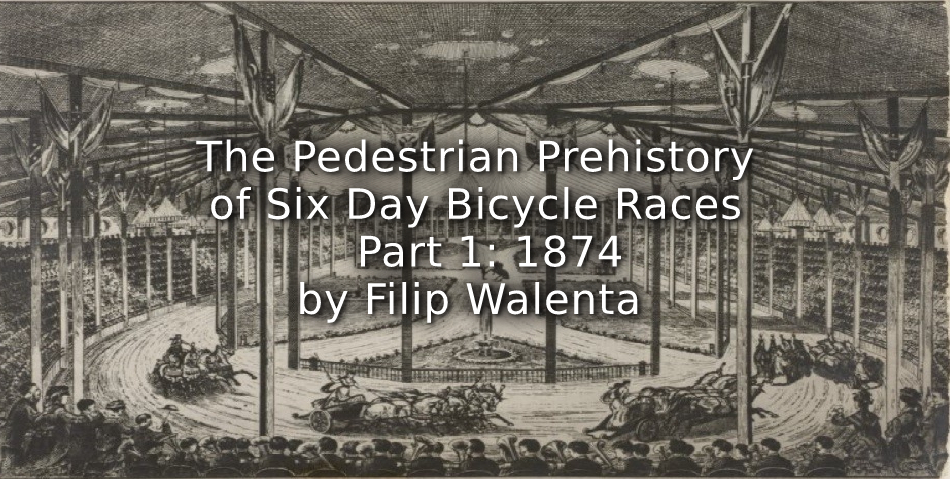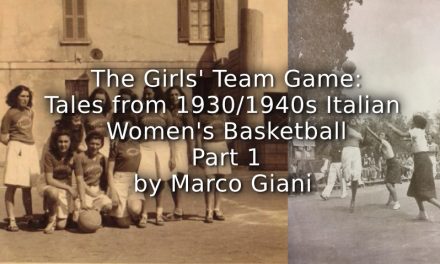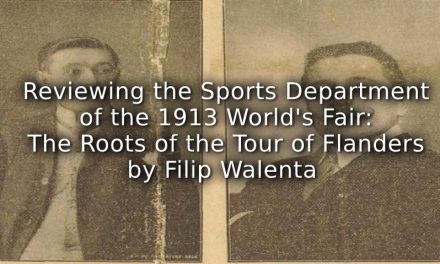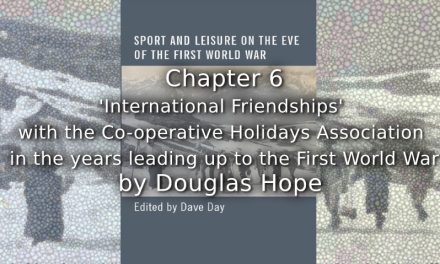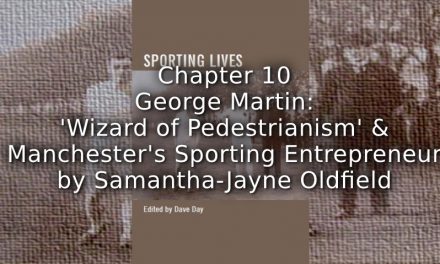Introduction
On Monday, November 1, 1875 the professional cyclist David Stanton completed the first multi-day cycling contest inside a sports infrastructure. He rode six hundred and fifty miles in seven consecutive days (consisting of twelve hours) with more than one hour to spare at the Lillie Bridge sporting grounds of West Brompton near London.[1]
When we think about six-day racing, our mind automatically tends to make the link to what it represents in our current perspective: the (indoor) six-day cycling events. However, six-day racing was not invented within the cycling world, its heritage originates from several other sporting disciplines. An in-depth analytic and cross-sports-disciplinary research would provide us a clear view of the prehistory of this specific cycling discipline. One aspect of the prehistory of six-day bicycle racing we find back in long-distance pedestrianism.
Long-distance pedestrian racing
In the nineteenth century endurance pedestrianism was one of the most popular spectator sports in the US and UK. Especially the UK has a long tradition way back to the late eighteenth century with among others Foster Powell, who walked in November 1773 from London to York and back covering a total distance of four hundred and twenty miles in six consecutive days.[2] The popularity of endurance walking reached its peak level a century later in the Northeastern United States with an increasing number of six-day races and other long-distance feats.
Edward Payson Weston, born in Providence, Rhode Island in 1839, was a publisher and door-to-door bookseller who had made a career switch as a professional long-distance pedestrian during the early eighteen sixties. As a consequence of the huge success of the improvement of roller skates by James Leonard Plimpton, the first public roller skating rinks opened their doors in New York en Newport, Rhode Island, in eighteen sixty six.[3] Inspired by his former background of circus and variety acts, about ten years after making name in several one and two thousand-mile interurban races, he immediately recognized the promotional and lucrative opportunities of this new kind of sports infrastructure and introduced a new concept of indoor endurance walking. Instead of crossing the US territory the short tracks in hippodromes, roller skating rinks and circuses attracted a lot more attention of the local population and press. It was a lucrative business for the event management by generating higher revenue of entrance fees, catering and bookmaking of visiting spectators.[4] The variety halls and skating rinks provided a free solution for amateur pedestrians who could not effort to lease a descent infrastructure, while their famous professional colleagues could claim a percentage of the turnover for their performances. Sometimes the pedestrian races were a part of multiple variety events, musically accompanied by an orchestra. The spectators could witness several acts at the same time, while relaxing at a table with a cup of thee or a drink. And instead of braving all kinds of harsh weather conditions along muddy paths and steep hills the athletes were ensured that their sporting achievements were able to continue in the best of circumstances.
At the end of 1874 Weston succeeded to walk five hundred miles in six consecutive days at the Newark roller skating Rink in New Jersey. Less known is that his stunt was preceded by several unsuccessful attempts of different pedestrians, indicating it had to be an enormous physical task.

‘Edward Payson Weston’s pedestrian exhibition, May 7, at the American Institute Hall, preliminary to his five-hundred-mile walk’.[5]
First attempt in the American Institute Hall, Manhattan from 11 till 16 May 1874
Weston’s first six-day walk was organized in May 1874 from Monday the 11th till the next Saturday the 16th in the American Hall Institute in Manhattan, New York. In June 1871 he accomplished to walk four hundred miles in five days in the Empire City Skating Rink, after a failure the year before.[6][7]
Already a week before the start the event got a lot of attention and was promoted daily in the local press as follows: “GREAT TRIAL OF ENDURANCE. WESTON’S GREATEST EFFORT. Walking 500 Miles in Six Days. 115 Miles within 24 Hours. EDWARD PAYSON WESTON will undertake this task in AMERICAN INSTITUTE HALL, Sixty-third street and Third avenue, May 11, 12, 13, 14, 15, 16. GRAND PROMENADE CONCERT each Afternoon and Evening. Admission 50 cents”.[8] And during the race daily in-depth analyses of Weston’s progression, nourishment, sleeping behaviour and other physical and mental aspects were published in extensive and detailed articles.
Weston started off enthusiastically on Monday morning by walking a distance record of one hundred and fifteen miles in twenty four hours, much to the regret of several members of the Union Club (of the City of New York). According to rumors they had bet that Weston would not succeed and lost around thirty thousand dollars.[9] On Tuesday and Wednesday Weston had to slacken the pace and interrupt his efforts several times for treatment of injuries he suffered from since the end the first day. A wrinkling sole in his boot had caused two large painful blisters on his left foot. This had put him too far behind on the planned schedule and he would never be able to catch up again the days after. By Saturday midnight Weston stopped exhausted in the presence of more than six thousand spectators after a walking endeavor of four hundred and thirty miles.[10] Nevertheless his failure he was given an immense applause by the crowd for his effort and for breaking the twenty four-hour record in particular.[11]
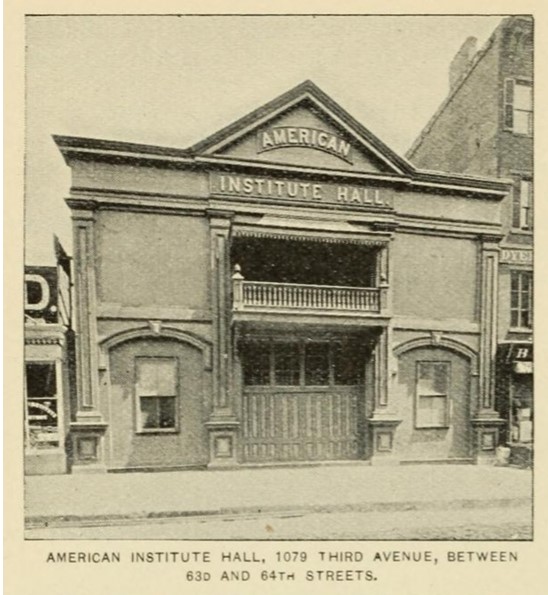
The American Institute Hall in Manhattan, New York.[12]
Second attempt in the Washington Riding Academy, Manhattan from 15 till 20 June 1874
A second attempt was organized five weeks later in the Washington Riding Academy, at the corner of the Sixth Avenue and Twenty-Sixth Street in Manhattan by Edward Mullen. Mullen, who was born and lived in Boston, had only competed in short distance races of no more than twelve miles. The constant presence of his trainer and a massage therapist during the event gave the impression of professional guidance, contrary to Mullen’s physical preparation as he was convinced that a moderate training program would be sufficient to clear the job.[13] Unfortunately Mullen terminated his effort on Saturday noon after having completed four hundred and thirty four miles, realizing that he could not make it to the finish by midnight.[14]
Anyway, his race would never be recognized because during the course of the week a bright-eyed reporter of The New York Herald found out that Mullen’s record attempt was based on a fraud. After subsequent remeasurement of the track by several reporters it turned out that its actual distance was around two hundred and forty feet instead of the claimed three hundred feet by Mullen’s entourage.[15] Mullen argued in his own defense that he had not measured the distance personally and therefore could not be held responsible for the ‘mistake’.[16]
Third attempt in the Barnum’s Grand Roman Hippodrome from 20 till 25 July 1874
After his fraudulent attempt in the Washington Riding Academy, Mullen tried to break the five hundred-mile record again a month later. This time the arena was situated in the circus of P.T. Barnum in Manhattan, New York. In the spring of 1874 the American show and businessman Phineas Taylor Barnum leased the site of an abandoned railway station of the New York and Harlem Railroad, owned by William Henry Vanderbilt. He renovated it into a massive construction with a museum and a stadium occupying the entire block. P.T. Barnum’s grand Roman Hippodrome as it was called was the first stadium with a retractable roof in the United States. It measured four hundred feet long and two hundred feet wide and had a capacity of ten thousand seats.[17] At the opening on the 27th of April the construction was announced as ‘The largest place of amusement in the world, occupying the Block bounded by Madison and Fourth Avenues, 26th and 27th Sts’.[18] Five years later the site was renamed as the (first) Madison Square Garden.[19]
Looking for new ways of entertainment Barnum introduced pedestrian races in the last shows of the summer season. In July he invited letter carriers from New York to compete short pedestrian races. [20] After the experiment was well received by the audience Barnum decided to include long-distance pedestrian races in his program on a regular basis.
To the occasion of the closing days in July before setting up a movable circus in Boston in August, an extensive program was presented. The regular performances such as horse, elephant and camel races and other several circus acts were held twice a day, and on Tuesday and Friday afternoon a balloon ascension was scheduled. In between the events people could visit an Irish fairground and the zoological institute, or watch Mullen’s five hundred-miles walk. For those who wanted to follow Edward Mullen the box office was open all hours of the day and night at a lowered entrance fee of fifty cents.[21]
Short after midnight on Monday morning July 20, Mullen started his walk at the inner circle of the hippodrome, which was especially made for the occasion, under the constant supervision of race officials and members of the Committee of Arrangements.[22] Already at the end of the first day he was way behind the estimated schedule, and it was clear that he would never reach the proposed distance. Mullen suffered from lameness and took too much rest. He blamed it on a swollen knee, an injury at an exhibition walk a few weeks earlier of which he was not fully recovered from.[23] On Wednesday morning the management of the Hippodrome decided to pay out the contract and remove Mullen from the track rather than letting him continue his ridiculous race. The New York Herald wrote that “the consolation in this undisguised fizzle is that he will never more be able to face a New York audience”.[24]
To compensate Mullen’s failure Barnum quickly contacted another pedestrian for a walking feat on the very last days of July. On Wednesday the 29th Cornelius W. Payn tried to walk hundred and fifteen miles within twenty four consecutive hours. Unfortunately, after a promising start with an average speed of more than five miles per hour he had to abandon the race, having accomplished only sixty seven miles.[25]

P.T. Barnum Grand Roman Hippodrome where later the first Madison Square Garden was erected.[26]
Fourth attempt in the Barnum’s Great Traveling World’s Fair in Boston from 10 till 15 August 1874
Nevertheless Mullen’s failure Barnum saw the stimulating impact of pedestrian races on the visitor numbers. Once the movable hippodrome was erected in Boston he quickly decided to schedule an endurance pedestrian feat. George F. Avery, born in Maine in 1854 and living in Boston, was signed up to walk five hundred miles in six days during the second week of August.[27] He had already proven himself as a long-distance pedestrian by walking a hundred miles feat in less than twenty two hours. Short after midnight on Monday, August 10, Avery entered the hippodrome full of confidence while he was warmly welcomed by his fellow townspeople.[28] Unfortunately already during the course of the first day he became ill as he obviously was not well prepared for this kind of physical strain. On Tuesday afternoon he broke down by stomach problems and had to leave the hippodrome after a disappointing one hundred and one mile-walk.[29]
Fifth Attempt in the Barnum’s grand Roman Hippodrome from 14 till 19 September 1874
The second attempt of Edward Payson Weston was planned on Monday morning September the 14th in the Barnum’s Roman Hippodrome. In a contract that was signed three weeks before the start Mrs Weston was promised a five thousand dollar purse by P.T. Barnum in case of a successful race, and thousand dollars in case of his failure.[30] For the occasion the hippodrome was repainted and redecorated by several workmen during the week before the event. A four feet wide track measuring exactly one-seventeenth of a mile was laid out under supervision of the city surveyor. At night the track was lighted by seventeen reflecting chandeliers. During the entire six days six representatives of four local newspapers attended the event: The New York World, The New York Herald, The Sun and The New York Times.[31]
Although he had hardly slept in the previous two days Weston appeared seemingly fresh on Monday morning in the presence of two doctors of the Bellevue Hospital and five companions in the hippodrome where two hundred spectators were waiting to witness the start. On his arrival Weston was offered a colorful Russian leather cap by the famous English actor Edward Askew Sothern.[32]
On Wednesday Weston made a weary impression as he began to grow seriously ill from a migraine attack. He had to take several extra hours of rest that consequently put him far behind schedule. But Weston perseveringly kept on walking in order to make the best of it, although he realized he would not reach his goal.[33] On Saturday evening a letter signed by several distinguished gentlemen was read publicly, asking P.T. Barnum to give Weston another trial. Barnum, who married his forty years younger bride on Wednesday and was enjoying his honeymoon, had already answered by telegram that the hippodrome was at his disposal in October.[34] At fifteen minutes to midnight Weston ceased his walk after three hundred and twenty six miles. He thanked the race management and the spectators for their attendance and support, while he was given three cheers by the crowd.[35]
Sixth attempt in the Barnum’s grand Roman Hippodrome from 5 till 10 October 1874
Weston’s third attempt started off two weeks later on Monday the 5th of October in the Barnum’s Roman Hippodrome in the presence of several prominent New York citizens, among which the city Mayor and the Common Council.[36] On Wednesday Weston started suffering from overheating of the sole of his left foot and although he had been treated for several blood blisters the days after he persisted to continue. By midnight on Saturday he closed the trial having done only 346 miles.[37]
Because of his umpteenth failure Weston was attacked heavily by the local press. He was called a show off with a sick need for attention and a fraudster who enriched himself with gate money. Weston would never be able to accomplish the feat of walking five hundred miles in six days and if he would ever try another attempt it would be better not in New York. Also the fact that Weston promoted the habit of walking as a healthy recreation sport was strongly criticized: “Westonism in morals, politics, business, religion, locomotion and literature is a stupendous fraud”. He was commented “Instead of walking round and round in circles, six day steady walking would take him a very respectable distance from the city” and advised “to walk off on his ear so people could get rid of the annoyance of the epoch”.[38]

Interior view of the P.T. Barnum’s Roman Hippodrome [39]
Seventh attempt in the American Institute Hall from 7 till 13 December 1874
In November the Englishman John Richard Judd, a professor of physical culture and athletic training from New York, declared to make an attempt to complete the five hundred-mile assignment in the first or second week of December. As he was convinced that walking the distance in six days was beyond the limits of human endurance ability, he would do the feat in six consecutive days and twelve hours. Under the name John Davidson he had already proven to be a long-distance pedestrian on several occasions. He had successfully walked several times one hundred hour feats with only half an hour rest per day. And while walking sometimes he carried an anvil weighing one hundred and fifteen pounds on his shoulder during half an hour or for a distance of half a mile. Consequently he was considered to be the only man who could clear the job. Remarkable here is that in an article of The New York Herald we get an idea of the training methodology Judd applied as preparation for his long-distance race. As a specialist in athletic training he was convinced that a most persistent and industrious training was required. The training was started several weeks before the feat by walking ten or fifteen miles per day, gradually increasing up to fifty-sixty miles. Three to four days before the feat he would stop the workouts and take a thorough rest. A gradual increase of physical strain by walking longer distances or more hours was followed by a short rest period just before the start of the competition. [40] This training technique resembles much to the same principle as the modern tapering off period before an important long-distance race in order to start at the best possible physical condition. A last exhibition test of five miles was performed on Wednesday afternoon, December 2, in the Newark skating Rink.[41]
Place of the six-day race was the American Institute Hall in Manhattan. Although the first days Judd started off with a promising average speed of four to five miles per hour, halfway the week he could not hold a steady pace and became way behind. On Saturday his left ankle and knee swell terribly as a result of a sprain and when he sunk down exhausted during the evening he had to be taken from the track.[42] After a quick examination of the injury by his medical adviser Judd had to abandon the race after 369 miles.[43]
Eighth and successive attempt in the Newark Rink (New Jersey) from 14 till 19 December 1874
On Saturday, November the 28th Weston did a final endurance test of one hundred miles in the Newark Rink, which he finished in twenty one hours and thirty three minutes.[44]
On Monday, December the 14th he started his fourth six-day walk. The attendance in the Newark Rink was quite moderate while his attempt was announced sarcastically in the press as ‘Weston’s following failure’.[45] A similar attempt was planned by another pedestrian John Manley on Thursday in Newark but as further information was not available he probably did not start.[46] In full confidence as a result of a carefree course, partially due to the track superior to that at Barnum’s hippodrome, and in first class condition Weston finally accomplished the feat on Saturday night.[47] With twenty five minutes to spare and in the presence of an excited crowd of more than six thousand spectators he completed the five hundred-mile record.[48] His success was widely reported in the press and mentioned in the chronological history of the year.[49]
Other long-distance pedestrian feats in 1874
All these examples indicate that the US and Manhattan, New York, in particular was the center of endurance pedestrianism in 1874. However, the long-distance pedestrian mania was not only represented by six-day races and twenty-four-hour records. Other challenges were engaged as well as in the US as in the UK.
On Saturday, June 27, the mule spinner Hugh Donahue completed at Hampden Park in Springfield, Massachusetts, the staggering task of walking one thousand miles in one thousand consecutive hours, a feat that was only preceded in 1809 by Captain Robert Barclay Allardice at Newmarket, England.[50][51]
Two days later Miss Richards from Stapleton near Bristol (UK) concluded the same superhuman effort. Strangely enough, very few bets were made, one of which was only fifty pounds won by her father.[52]
In the same week of Weston’s third attempt in October in P.T. Barnum’s Hippodrome, a few blocks away in the Grand Central Hall in Manhattan’s 42nd Street the Californian James Kennaren tried to walk seventy five consecutive hours with only ten minutes rest per day while carrying a regulation musket.[53][54]
After a successive walk of hundred miles on July 14, the Irish door-to-door bookseller Daniel O’Leary tried to walk hundred and five miles in twenty four hours on August 21, 1874 in the West Side (skating) Rink in Chicago. Although he suffered from a swollen hand, the result of a bite of a pet monkey the week before, he cleared the job in twenty three hours and eighteen minutes.[55] And in November he walked two hundred miles in less than thirty seven hours.[56] The following year O’Leary became the main opponent of Weston in long-distance walks.
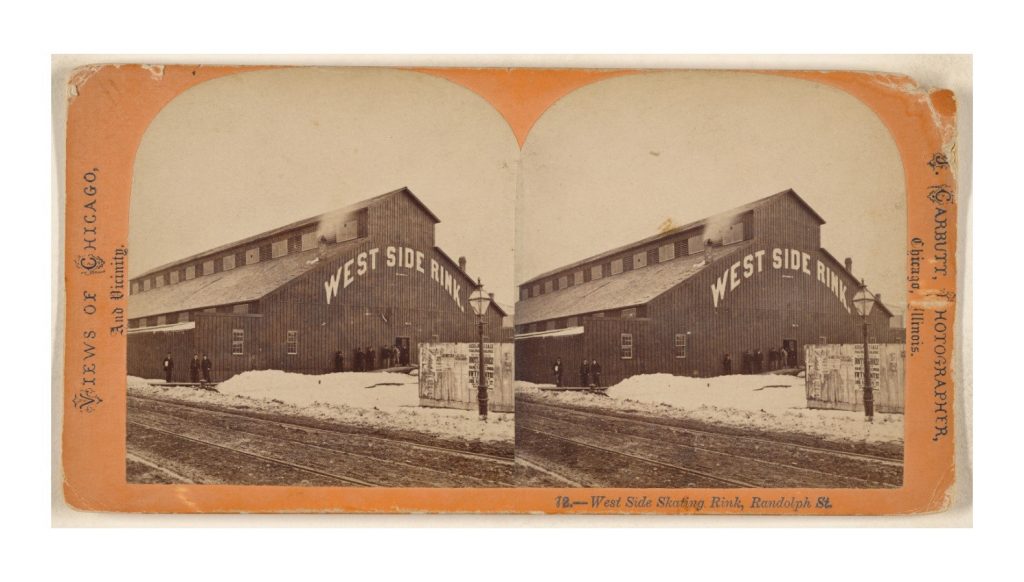
The West Side (skating) Rink in the Randolph Street, Chicago, around 1865. (Photo: postcard)
In the eighteen seventies pedestrianism not only became a mass spectator sport, but also enjoyed increasing popularity as a leisure sport. In August 1874 a remarkable recreational pedestrian tour was made by a group of four young gentlemen, among which Ulyssus, Jr. and Jesse Grant, sons of President Grant. During their six-day trip of one hundred and thirty seven miles they crossed the Allegheny Mountains from Huntington to Pittsburg, Pennsylvania. And in Europe the Dutch gentleman Dudock De Witt, a well respected pedestrian who already had crossed Japan, China and the two America’s, walked from Amsterdam to Paris, a trip of more than four hundred miles in a period of nine days.[57]
Conclusion
Endurance pedestrianism was by far the most popular sport in the United States in the eighteen seventies. As walking races found their way to large variety halls and sometimes were included into the daily program of theaters and circuses, pedestrianism became a mass spectator sport and contributed to the emergence of the proto-mass culture of the late nineteenth century. And by following the opening hours of the different sports and variety infrastructures twenty-four-hour records and six-day races became the standards of long-distance pedestrianism. The indoor walking feats became variety acts and the subject of bookmaking opportunities, with the pedestrians as their performers and pawns in the gambling game. The press also noticed the increasing popularity of endurance walking and in some cases the reporters even made part of the organizing staff as race directors or supervisors. Although sometimes the athletes were heavily attacked after a failure, the press undoubtedly contributed to the notoriety of the sport and the hero status some pedestrians enjoyed.
Considering its immense popularity it is not coincidental at all that, once the bicycle was strong enough to withstand a multi-day load, long-distance pedestrian feats were copied to the cycling sport and contributed to the emergence of the first six-day bicycle races in the following years.
Article 2022 © Filip Walenta
To read Part 2 Click HERE
References
[1] The Teesdale Mercury, November 10, 1875.
[2] Laws, Bill, Byways, Boots and Blisters: A History of Walkers and Walking (Stroud, 2008) 27-29.
[3] Roller skating, Wikipedia, The Free Encyclopedia.
<https://en.wikipedia.org/wiki/ Roller_skating> (Accessed: February 1, 2022).
[4] Algeo, Matthew, Pedestrianism: When Watching People Walk Was America’s Favorite Spectator Sport (Chicago, 2014) 22-23.
[5] The Days’ Doings, May 23, 1874, 16.
[6] The New York Herald, June 4, 1871; The Sun., June 17, 1871.
[7] Evening Courier and Republic., November 21, 1870.
[8] The Brooklyn Daily Eagle, May 7, 1874; The New York Herald, May 3, 1874; Ibid, May 7, 1874; Ibid, May 9, 1874; New York Tribune, May 13, 1874.
[9] The Days’ Doings, May 23, 1874.
[10] Chicago Daily Tribune, May 18, 1874.
[11] The Plattsburgh Sentinel., April 22, 1874.
[12] King, Moses, King’s handbook of New York City, (1893), 320.
[13] The New York Herald, June 15, 1874. Ibid, June 18, 1874.
[14] The New York Herald, June 21, 1874.
[15] Evening Courier and Republic, June 19, 1874; The New York Herald, June 19, 1874.
[16] The Long-Islander, July 24, 1874.
[17] Algeo, Matthew, Pedestrianism: When Watching People Walk Was America’s Favorite Spectator Sport (Chicago, 2014), 99.
[18] Folder of P.T. Barnum’s Great Roman Hippodrome.
[19] Madison Square Garden, Wikipedia, The Free Encyclopedia.
<https://en.wikipedia.org/wiki/Madison_Square_Garden> (Accessed: January 24, 2022).
[20]The New York Herald, July 6, 1874.
[21] The Brooklyn Daily Eagle, July 17, 1874; Ibid, July 20, 1874.
[22] The New York Herald, July 18, 1874.
[23] Slout, William L., From Rags to Rickets and Other Essays on Circus History (1997), 41.
[24] The New York Herald, July 24, 1874.
[25] The New York Tribune., July 30, 1874.
[26] The Daily Graphic, March 5, 1874.
[27] Crocket, Davy, ‘94: The Six-Day Race Part 3: P.T. Barnum – Ultrarunning Promoter (1874)’, Ultrarunning History, 2021. <https://ultrarunninghistory.com/p-t-barnum/> (Accessed: January 11, 2022).
[28]Boston Evening Transcript, August 11, 1874.
[29] Ibid, August 12, 1874.
[30] The New York Herald, September 11, 1874.
[31] The Ogdenburgs Journal, September 17, 1874.
[32] The Sun., September 14, 1874.
[33] The Sun., September 18, 1874; Ibid, September 21, 1874.
[34] The Evening Gazette., September 17, 1874.
[35] The Sun., September 21, 1874.
[36]The New York Herald, October 4, 1874.
[37] The New York Herald, October 11, 1874.]
[38] The Brooklyn Daily Eagle., October 10, 1874; The Evening Star, October 10, 1874; The New York Herald, October 13, 1874.
[39] The Daily Graphic, March 5, 1874.
[40] The New York Herald, November 6, 1874.
[41] The New York Herald, December 3, 1874.
[42]The Rutland Daily Globe, December 17, 1874.
[43] The New York Herald, December 13, 1874.
[44] The Chicago Daily Tribune, December 6, 1874.
[45] The New York Herald, December 15, 1874.; Elmira Daily Advertiser., December 18, 1874.
[46] The Sun, December 15, 1874.
[47] The New York Herald, December 20, 1874.
[48] Evening Courier and Republic., December 22, 1874.
[49] The Evening Post., December 31, 1874.
[50]The New York Herald., June 28, 1874.
[51] Robert Barclay Allardice, Wikipedia, The Free Encyclopedia. <https://en.wikipedia.org/wiki/Robert_Barclay_Allardice> (Accessed: January 11, 2022).
[52] The Merthyr Telegraph, July 3, 1874.
[53] The New York Herald, October 6, 1874; The Brewster Standard., October 9, 1874.
[54] The Grand Central Hall was most likely the main entrance of the Grand Central Depot (1871), in 1900 renamed as the Grand Central Station or Terminal.
History of Grand Central Terminal, Wikipedia, The Free Encyclopedia. <https://en.wikipedia.org/wiki/History_of_Grand_Central_Terminal> (Accessed: January 13, 2022).
[55] The Chicago Daily Tribune., August 22, 1874; Ibid, August 23, 1874.
[56] The Pilot, October 10, 1874; The Chicago Daily Tribune., October 8, 1874.
[57] The Chicago Daily Tribune., August 20, 1874.
Other resources
Library of Congress. < https://www.loc.gov/newspapers/> (Accessed: February 1, 2022).
NYS Historic Newspapers. < https:// https://nyshistoricnewspapers.org//> (Accessed: February 1, 2022).

